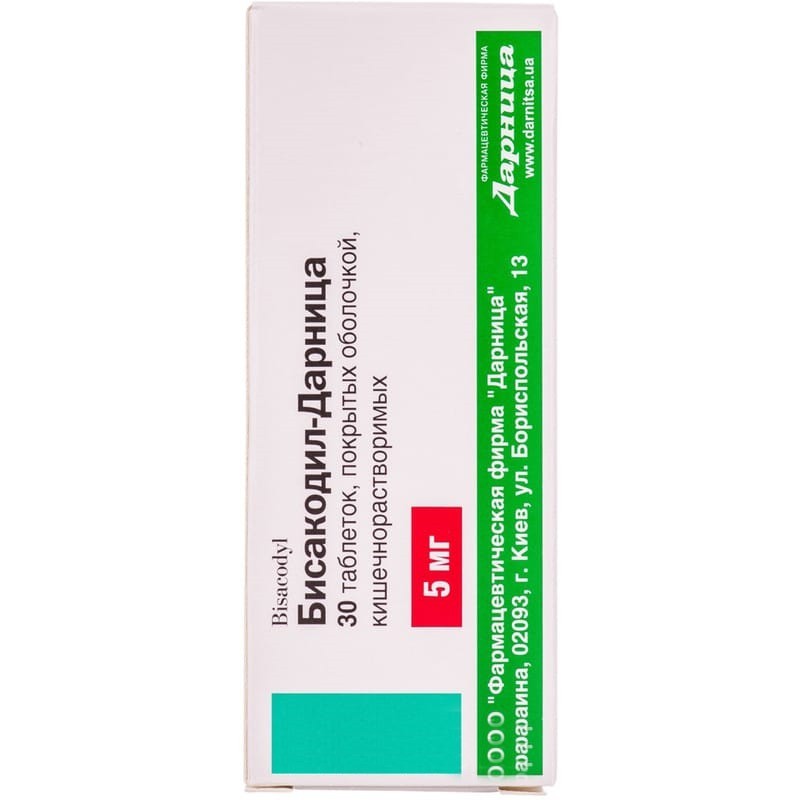



 Secure and encrypted payment processing
Secure and encrypted payment processing We ship to over 40 countries including the USA, UK, Europe, Australia and Japan
We ship to over 40 countries including the USA, UK, Europe, Australia and Japan Guaranteed refund or reship if you haven't received your order
Guaranteed refund or reship if you haven't received your orderbisacodyl causes a laxative effect, which is manifested by softening or thinning the stool. the mechanism of the laxative effect is due to an increase in the penetration of water into the intestinal cavity and a decrease in its absorption, as well as an acceleration of intestinal motility.
An important place in the mechanism of action is the splitting of bisacodyl in the alkaline contents of the intestine, which leads to the formation of substances that irritate the receptors of the intestinal mucosa. This leads to stimulation of intestinal motility.
Pharmacokinetics Intestinal and bacterial enzymes quickly convert bisacodyl into its active metabolite. Only 5% of the oral dose is absorbed into the systemic circulation, transformed in the liver and excreted in the urine, bile in the form of an inactive metabolite (glucuronides).
Short-term symptomatic treatment for constipation. preparation of the intestine for diagnostic tests, before surgery (under the supervision of a doctor). the clinical need to facilitate bowel movements with hemorrhoids, anal fistulas and fissures.
For effective bowel movements in the morning, the drug is used orally before bedtime, regardless of food intake. the tablet should be swallowed without chewing, washed down with a full glass of water.
For short-term treatment of constipation, to facilitate bowel movements with hemorrhoids, anal fistulas and fissures:
To prepare for diagnostic procedures and before surgery (under the supervision of a doctor):
It is not recommended to use the drug for more than 7 days, daily use of the drug is undesirable.
Hypersensitivity to bisacodyl or any other component of the drug; acute proctitis, acute hemorrhoids, spastic constipation, bowel obstruction, strangulated hernia; gastrointestinal bleeding, uterine bleeding; acute abdominal syndrome, including appendicitis, other acute inflammatory bowel diseases, peritonitis, severe abdominal pain, accompanied by nausea and vomiting (these symptoms may be manifestations of the above serious conditions); Crohns disease, ulcerative colitis; severe dehydration.
From the central nervous system and the peripheral nervous system: dizziness, weakness, loss of coordination of movements, orthostatic hypotension, periodic cramps of the calf muscles (krampi), in severe cases - vasospasm.
From the digestive system: discomfort in the abdominal cavity, spastic abdominal pain, flatulence, nausea, vomiting, diarrhea, thirst, dry mouth, intestinal colic, irritation of the rectum may occur, prolonged use can lead to intestinal atony, large intestine melanosis colitis.
Metabolic disorders: disturbances in the water-electrolyte balance (metabolic acidosis / alkalosis, hypokalemia, hypocalcemia) especially in the elderly.
Allergic reactions: anaphylactic reactions, hypersensitivity reactions, skin rashes, itching, angioedema.
When using the drug bisacodyl-darnitsa, it should be remembered that the tablet is coated with an enteric-soluble membrane, so the tablet cannot be divided and chewed.
The drug can not be washed down with alkaline mineral water, used for 1 hour along with milk, antacids or N blockers2receptors.
Use with caution for treatment in patients with liver and kidney diseases.
Avoid prolonged, more than 7 days, and the systematic use of the drug, as this can lead to intestinal atony and the impossibility of defecation without the use of strong laxatives.
It is contraindicated in case of abdominal pain of unknown origin, accompanied by nausea and vomiting.
In elderly people, due to the frequent use of the drug, asthenia, orthostatic hypotension, and coordination disorder may occur.
The lack of stimulation of the act of defecation with the drug may indicate an organic cause of constipation.
The drug contains lactose, therefore, patients with rare hereditary galactose intolerance, Lapp lactase deficiency or glucose-galactose malabsorption should not use the drug.
Use during pregnancy and lactation. It is not recommended to use the drug during pregnancy and lactation due to the lack of safety data for this group of patients.
Children. Do not use in children under 4 years of age. For children aged 4-10 years, the drug should be used only as directed by a doctor.
The ability to influence the reaction rate when driving vehicles or working with other mechanisms. During treatment, care should be taken when driving vehicles or working with other mechanisms, and in case of dizziness, refrain from potentially dangerous activities that require an increased concentration of attention and speed of psychomotor reactions.
It is not recommended to use the drug simultaneously with H2 receptor blockers, dairy products and antacids (within 1 h), since there is a risk of rapid dissolution of the outer shell of the tablet and, as a result, irritation of the mucous membrane of the stomach and duodenum, and a decrease in the effectiveness of bisacodyl.
Do not use alkaline products during the use of the drug and within 1 hour before and after administration.
The laxative effect of bisacodyl can cause potassium deficiency, therefore caution should be exercised when combined with bisacodyl using the following drugs: diuretics, beta-adrenergic agonists, corticosteroids (mineralocorticoids and glucocorticoids), amphotericin B, tetracosactide or drugs whose toxicity increases with a lack of potassium in the body (for example cardiac glycosides).
Astemizole, terfenadine, erythromycin, amiodarone, sotalol, quinidine preparations are not recommended to be combined with bisacodyl.
Symptoms the use of the drug in high doses can cause diarrhea, abdominal cramps, electrolyte imbalance (including symptoms of hypokalemia and functional atony of the colon). chronic overdose can lead to chronic diarrhea, abdominal pain, hypokalemia, secondary hyperaldosteronism, urolithiasis. cases of damage to the renal tubules, metabolic alkalosis and muscle weakness as a result of hypokalemia are described.
Treatment. Discard the drug and consult a doctor. Rinse the stomach or induce vomiting. Correction of water-electrolyte imbalance, the use of symptomatic agents are recommended.
In the original packaging at a temperature not exceeding 25 ° C.